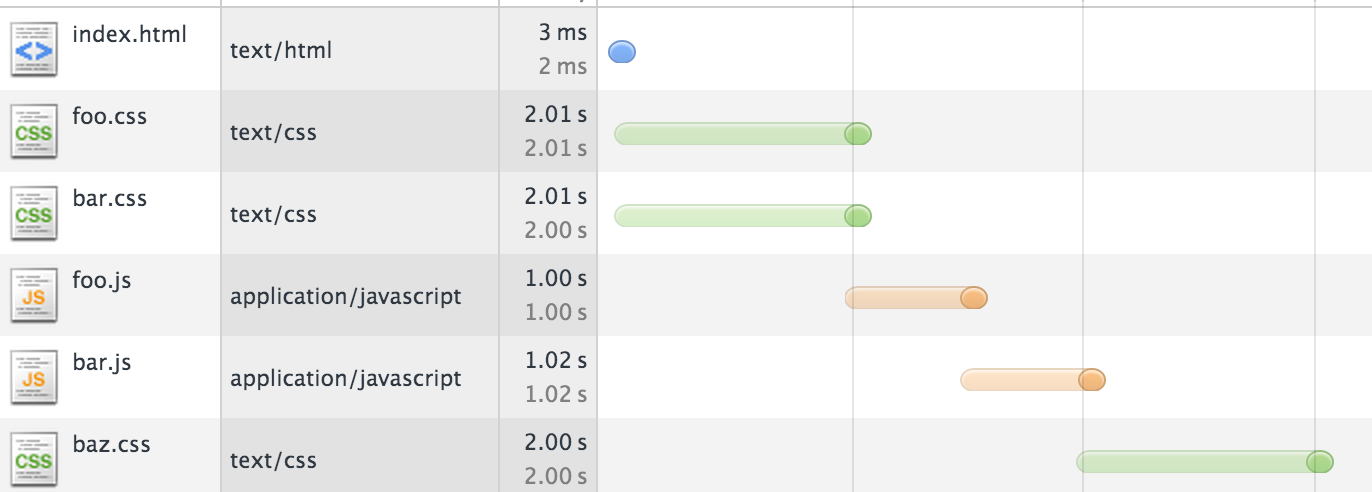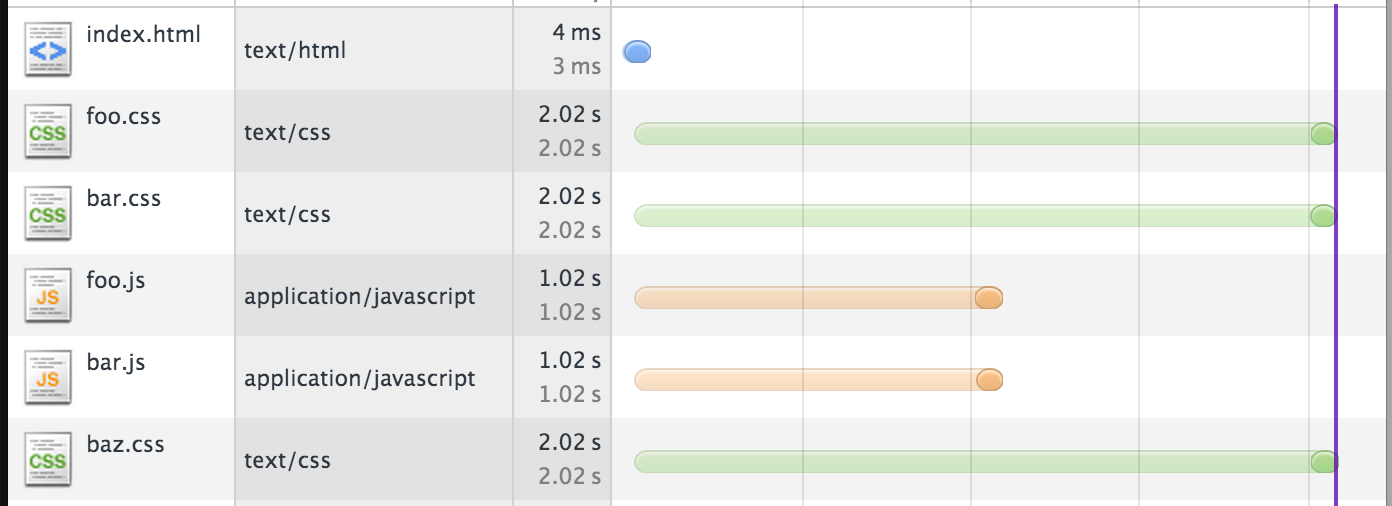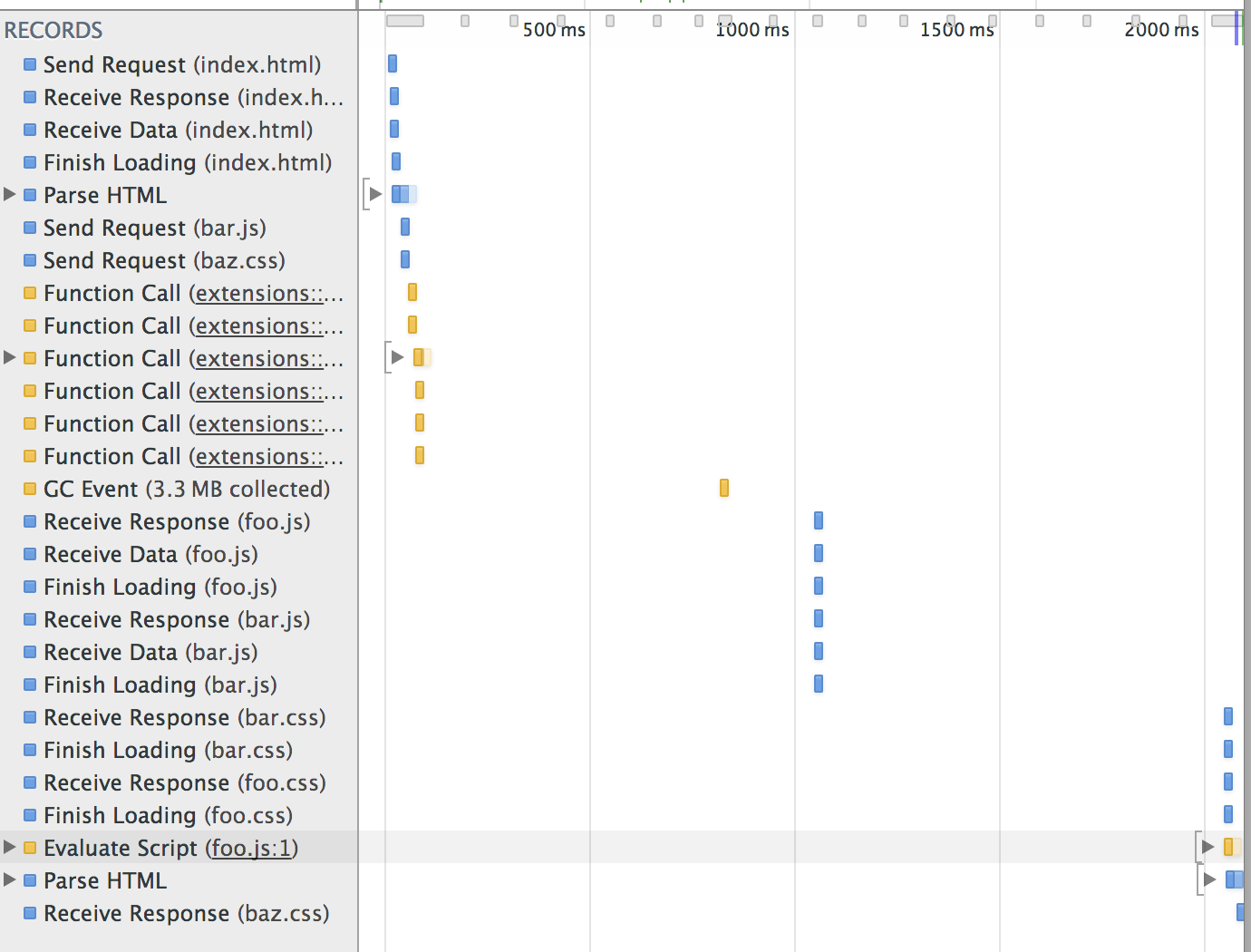Demystifying Sprockets
A.K.A. The Rails asset pipeline.
Forewords
How browsers used to work

How modern browsers works

But it's no silver bullet

HTTP Caching
The Last-Modified header
GET /ajax/libs/jquery/1.11.1/jquery.min.js HTTP/1.1
Host: ajax.googleapis.com
Accept: text/javascript
HTTP/1.1 200 OK
Content-Type: text/javascript; charset=UTF-8
Last-Modified: Tue, 13 May 2014 02:26:31 GMT
Date: Thu, 10 Jul 2014 08:51:40 GMT
<94 KB of JS>
GET /ajax/libs/jquery/1.11.1/jquery.min.js HTTP/1.1
Host: ajax.googleapis.com
Accept: text/javascript
If-Modified-Since: Tue, 13 May 2014 02:26:31 GMT
HTTP/1.1 304 Not Modified
<JS is not sent again>
HTTP Caching


But can do better.
HTTP Caching
The Expires / Cache-Control headers
GET /ajax/libs/jquery/1.11.1/jquery.min.js HTTP/1.1
Host: ajax.googleapis.com
Accept: text/javascript
HTTP/1.1 200 OK
Content-Type: text/javascript; charset=UTF-8
Cache-Control: max-age=31536000, public
Date: Thu, 10 Jul 2014 08:51:40 GMT
<94 KB of JS>
No other request will be issued for a year
Any Question at this point?
HTTP Caching


HTTP Caching
But how can I update my assets then?

Rails <= 3.0
Append the file mtime as query string
<script src="/javascripts/application.js?1405197924" ...
Drawbacks
- Some proxies (squid) used to ignore the query string
- Your deploy strategy need to preserve file properties
- Possible race condition if you have multiple servers
- Files are downloaded independently
Sprockets
Include the file MD5 in the file name
<script src="/assets/application-d3b07384d113edec49eaa6238ad5ff00.js"
Advantages
- Proxies cannot serve stale assets
- Hotlinking is not possible
- No more race conditions, assets are guaranteed to match your HTML
- Files are concatened together
Sprockets - The Directive Processor
//= require jquery
//= require_tree myapp
//= require_self
//= depend_on config
//= stub prototype
- Required file are included only once
- All required files are part of the MD5 sum
depend_ondo not include the file, but use it to compute the MD5 sumstubcan be useful to prevent one of your dependency from requiring somethinginclude(deprecated) likerequirewithout the unicity
Sprockets - The Engine API
# config.js.coffee.erb
@Config =
truth: <%= 21 * 2 %>
- Engines apply transformations on assets to convert them to another format based on extensions
Sprockets - The Engine API
class Csv2Json < Tilt::Template
def evaluate(scope, locals, &block)
JSON.dump(CSV.parse(data))
end
end
Sprockets.register_engine '.csv', Csv2Json
# foo.json.csv
Id,Name
1,George Abitbol
// foo-6d04991772b0ab12f0a96971ad290d68.json
[["Id","Name"],["1","George Abitbol"]]
- Engines are just tilt templates
- You can chain them as much as you want
- See them as compilers
Sprockets - Processors
Processors are Tilt templates like engines, but they do not convert the asset to another type
Sprockets.register_preprocessor 'text/javascript', RemoveBreakPoints
Sprockets.register_postprocessor 'text/javascript', PrependSafetySemiColon
Sprockets.register_bundle_processor 'text/javascript', MinifyJS
Note that processors are registered by MIME type while engines are registered by extensions.
- Preprocessors are ran before Postprocessors and Engines
- Postprocessors are ran after Preprocessors and Engines
- Bundle Processors are ran on concatenated assets rather than individual files.
Sprockets
Shorthand methods
environment.js_compressor = :uglify
environment.css_compressor = :scss
Sprockets - Helpers
The sprockets context provide helpers to engines, which can eventually expose them to the transormed assets
/* main.css.erb */
.header { background-image: url(<%= image_path('header-background.png') %>);}
They are mostly available in .erb assets.
// main.css.scss
.header { background-image: image-url(header-background.png); }
But some engines like SCSS provide integrated support
Sprockets - Helpers
Most usefull ones are:
image_path,font_path, etc. Gives you the digested path of another asset.asset_data_urigives you the Base64 encoded asset content (for embeding images).
And you can of course add custom ones
Sprockets - Integration
Even if he is often nicknamed "The Rails asset pipeline", Sprockets is actually framework agnostic
It can even easilly be used in non Ruby projects (PHP, Node, Python, etc)
Sprockets - Integration
# lib/sprockets_environment.rb
require 'sprockets'
module MyEnvironment < Sprockets::Environment
def initialize(production=true)
root = File.expand_path(File.join(__dir__, '..'))
super(root + '/public')
append_path(root + '/app/assets/javascripts')
append_path(root + '/app/assets/stylesheets')
append_path(root + '/app/assets/images')
if production
self.css_compressor = :scss
self.css_compressor = :uglifier
end
end
end
All the configuration would happen in a subclass of Sprockets::Environment
Sprockets - Integration
# config.ru
require 'sprockets_environment'
map '/assets' do
run MyEnvironment.new
end
Sprockets::Environmentacts as a rack middleware.- It will compile and bundle your assets on the fly when requested.
- No need to wonder if the compilation is done or not yet, your browser will wait until sprockets is done.
- This is intended for development.
Sprockets - Integration
# Rakefile
require 'rake/sprocketstask'
require 'sprockets_environment'
Rake::SprocketsTask.new do |t|
t.environment = run MyEnvironment.new
t.output = "./public/assets"
t.assets = %w( application.js application.css )
end
rake assets:precompilewill statically compile every listed bundles.- If the output directory is shared between releases, it will only compile what changed.
- A
manifest.jsonfile will be generated, containing all the mapping between the source files and the compiled files.
Sprockets - Integration
# in your app helpers
ASSETS_ROOT = 'https://my.cdn.com/assets/'
def sprockets
@sprockets ||= begin
env = MyEnvironment.new
ENV['RACK_ENV'] == 'production' ? env.index : env
end
end
def script_url(name)
ASSETS_ROOT + sprockets.find_asset(name + '.js').digested_path
end
script_url('application') # => 'https://my.cdn.com/assets/application-d3b07384d113edec49eaa6238ad5ff00.js'
- You will need a bit of glue in your application to always go through sprockets to link assets.
- The index is a faster version of the environment that rely only on the manifest.json.
- If you use something else than ruby, you'll have to parse the manifest.json yourself.
Common complaints
- Dependency management: https://rails-assets.org or bower.
- Slow compilation: make sure to share the
assetsdirectory between releases. - jQuery plugins with hardcoded paths: just use the
public/directory or fix the few URLs. - Most frontend tools are in JS: Use ExecJS
- Sourcemaps: yep... It's comming
Conclusion
Any Question?
Jean Boussier
Shopify
https://github.com/byroot